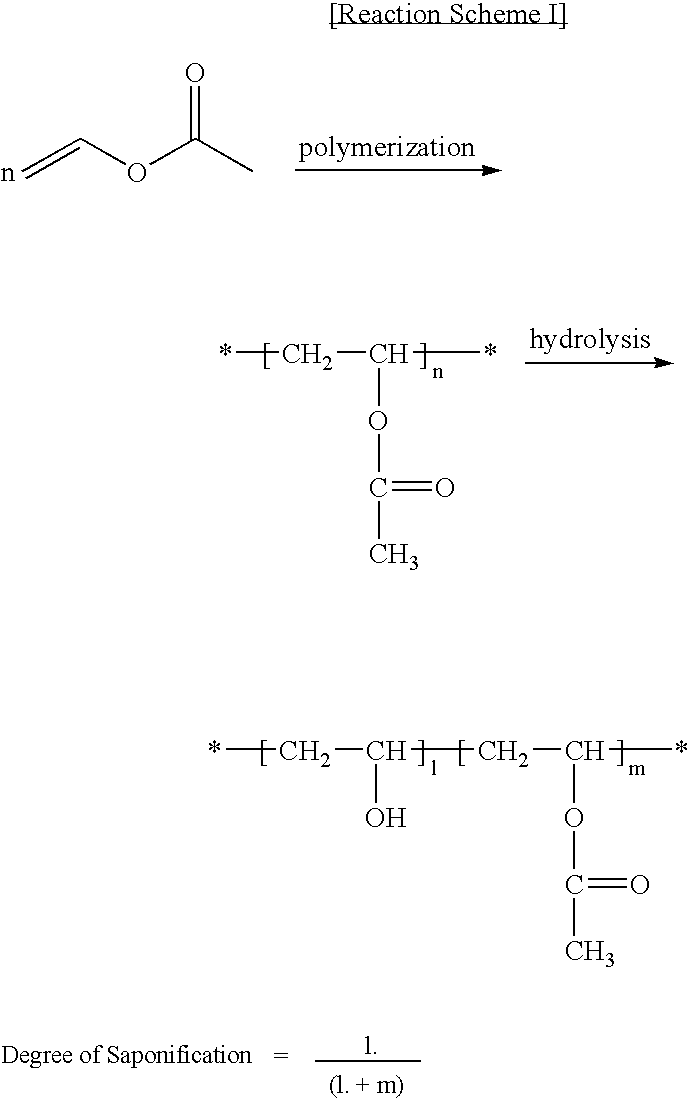Electrode material containing polyvinyl alcohol as binder and rechargeable lithium battery comprising the same
a polyvinyl alcohol and battery technology, applied in the direction of cell components, sustainable manufacturing/processing, other chemical processes, etc., can solve the problems of significantly reducing the capacity retention rate of the battery and thus shortened battery life, and achieve low viscosity, low electrolyte resistance, and the effect of effectively overcoming volume changes
- Summary
- Abstract
- Description
- Claims
- Application Information
AI Technical Summary
Benefits of technology
Problems solved by technology
Method used
Image
Examples
preparation example 1
[0051] 149 g of distilled water and 1.13 g of a suspension containing 2 wt % of a polyvinyl alcohol (PVA) (degree of saponification: 88%) were introduced and stirred in a reaction vessel equipped with a baffle at 200 rpm. The reaction vessel containing the distilled water and suspension was purged with nitrogen gas containing no oxygen and moisture for 1 hour. 0.05 g of azobisdimethylvaleronitrile was dissolved in 75 g of a vinyl acetate monomer and introduced into the reaction vessel which was then elevated to a polymerization temperature of 30° C. to undergo polymerization. The total reaction time was 10 hours, and the final conversion was 89%. The resulting polymerization products were washed, filtered and dried to obtain polyvinyl acetate. 500 g of a solution of the thus-prepared polyvinyl acetate in methanol (concentration: 10 wt %) was combined with 80 g of a solution of sodium hydroxide in methanol (concentration: 3 wt %) and the mixed solution was subjected to saponification...
examples 1 to 3
[0052] 47.5 g of dimethyl sulfoxide (DMSO) was added to 2.5 g of each binder as listed in Table 1, and the mixture was elevated with stirring to 90° C. over 10 min. The reaction contents were completely dissolved at that temperature for 1 hour and cooled to room temperature, thereby obtaining 5 wt % of binder solutions. The binder solutions were placed on an aluminum tray having a diameter of 7 cm and dried at 130° C. for 5 hours to obtain binder films. According to the procedure of Preparation Example 1, binders were prepared to have a desired degree of polymerization by appropriately adjusting an amount of an initiator and a reaction temperature.
experimental example 1
[0054] Each binder film fabricated in Examples 1 to 3 and Comparative Examples 1 to 3 was cut into round samples having a diameter of 1 cm and weighed. The samples were each soaked in 10 mL of Electrolyte A (ethylene carbonate:diethyl carbonate:ethyl methyl carbonate in a volume ratio of 4:3:3) and 10 mL of Electrolyte B (Electrolyte A containing 1M LiPF6), then sealed and stored in an incubator at 25° C. and 50° C., respectively. 72 hours later, the films were taken from the electrolyte and the remaining electrolyte on the film surface was wiped with a dry paper, followed by measuring changes in the weight of films relative to the initial weight.
[0055] The swelling rate of the films for Electrolyte A was calculated according to the following equation. Regardless of whether the swelling rate has a positive value or a negative value, the film having a lower swelling rate at 50° C. than at 25° C. was regarded as being dissolved in the electrolyte and was estimated as having a poor el...
PUM
| Property | Measurement | Unit |
|---|---|---|
| degree of polymerization | aaaaa | aaaaa |
| temperature | aaaaa | aaaaa |
| miscibility | aaaaa | aaaaa |
Abstract
Description
Claims
Application Information
 Login to View More
Login to View More - R&D
- Intellectual Property
- Life Sciences
- Materials
- Tech Scout
- Unparalleled Data Quality
- Higher Quality Content
- 60% Fewer Hallucinations
Browse by: Latest US Patents, China's latest patents, Technical Efficacy Thesaurus, Application Domain, Technology Topic, Popular Technical Reports.
© 2025 PatSnap. All rights reserved.Legal|Privacy policy|Modern Slavery Act Transparency Statement|Sitemap|About US| Contact US: help@patsnap.com

